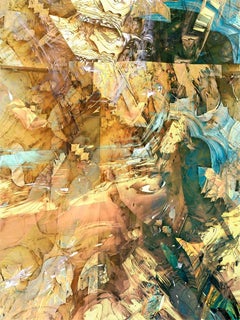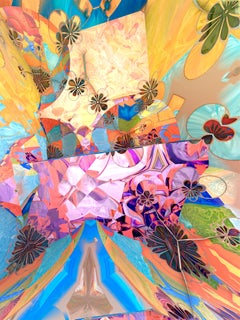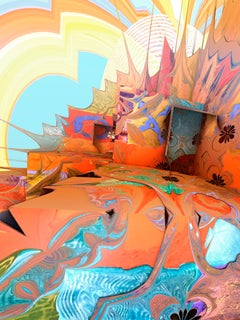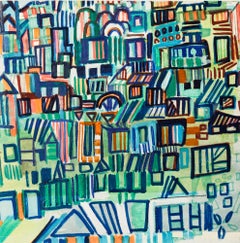New Media Abstract Drawings and Watercolors
to
6
1
3
3
2
1
4
1
1
Overall Height
to
Overall Width
to
4,655
1,605
313
242
116
90
83
40
22
16
15
15
11
1
6
6
6
3
3
3
3
Style: New Media
Seahorse Reef
By Teri Brudnak
Located in Boston, MA
Artist commentary:
The underwater world became a major inspiration to me when I learned how to dive. The plants and animals of the sea are surreal and beautiful-like nothing we see ...
Category
21st Century and Contemporary New Media Abstract Drawings and Watercolors
Materials
Watercolor, Panel, Digital, Mixed Media, Encaustic
Strata Rift
By Teri Brudnak
Located in Boston, MA
Artist commentary:
This piece is from a series about geological time and the layers that record it in the earth.
Words that describe the piece: geology ,stone, layers, gold
Category
21st Century and Contemporary New Media Abstract Drawings and Watercolors
Materials
Archival Paper, Digital
Bumblebee
By Teri Brudnak
Located in Boston, MA
Artist commentary:
This piece is from a series about pollinators. The bee is painted in watercolors and the entire piece is painted with encaustic (wax). Details are added with ligh...
Category
21st Century and Contemporary New Media Abstract Drawings and Watercolors
Materials
Mixed Media, Encaustic, Watercolor, Panel, Digital
Let There Be Light
By Teri Brudnak
Located in Boston, MA
Artist commentary:
This piece is a collage of a 3D fractal with a watercolor of a hummingbird moth. It is painted over and detailed with encaustic (wax) paints. The title refers to ...
Category
21st Century and Contemporary New Media Abstract Drawings and Watercolors
Materials
Encaustic, Watercolor, Panel, Digital, Mixed Media
Flowers in the Multiverse
By Teri Brudnak
Located in Boston, MA
Artist commentary:
Flowers do grow in the Multiverse! But they only show their shapes as negative space.
Words that describe the piece: colorful, flowers, bold, expressive
Category
21st Century and Contemporary New Media Abstract Drawings and Watercolors
Materials
Archival Paper, Digital
Door to the Dream Room
By Teri Brudnak
Located in Boston, MA
Artist commentary:
Magic happens in a space that is a room with a door to the subconscious mind.
Words that describe the piece: dreams, door, magic, colorful, abstract,
Category
21st Century and Contemporary New Media Abstract Drawings and Watercolors
Materials
Archival Paper, Digital
Related Items
"North Broad" Abstract cityscape, geometric pattern, triangle, mixed media panel
Located in Philadelphia, PA
This piece titled "North Broad" is an original artwork made from pencil, marker, acrylic gouache collage on panel by Miriam Singer. This piece measures 6"h x 6"w and is signed on the...
Category
21st Century and Contemporary New Media Abstract Drawings and Watercolors
Materials
Gouache, Panel, Permanent Marker, Pencil
My 80's Heart "Token 9" 2019, gouache, acrylic, graphite, panel, blue, orange
Located in Jersey City, NJ
My 80's Heart "Token 9" 2019, gouache, acrylic, graphite, panel, blue, orange, yellow
Category
2010s New Media Abstract Drawings and Watercolors
Materials
Acrylic, Gouache, Panel, Wood Panel, Graphite
My 80's Heart "Token 4" 2019, gouache, acrylic, graphite, panel, yellow, orange
Located in Jersey City, NJ
My 80's Hart "Token 4" 2019, gouache, acrylic, graphite, panel, yellow, orange
Category
2010s New Media Abstract Drawings and Watercolors
Materials
Acrylic, Gouache, Panel, Wood Panel, Graphite
1950s Abstract Composition in Brown, Orange and Blue with Black Parallel Lines
Located in Denver, CO
Watercolor and ink on paper of an abstract composition of brown, orange and blue shapes between black parallel lines throughout the the piece by Herbert Bayer (1900-1985). Presented in a custom black frame with all archival materials. Framed dimensions measure 17 ⅞ x 22 ⅝ x 1 inches. Image size is 10 ¼ x 15 ½ inches.
Painting is clean and in very good condition - please contact us for a detailed condition report.
Expedited and international shipping is available - please contact us for a quote.
About the Artist:
Herbert Bayer enjoyed a versatile sixty-year career spanning Europe and America that included abstract and surrealist painting, sculpture, environmental art, industrial design, architecture, murals, graphic design, lithography, photography and tapestry. He was one of the few “total artists” of the twentieth century, producing works that “expressed the needs of an industrial age as well as mirroring the advanced tendencies of the avant-garde.”
One of four children of a tax revenue officer growing up in a village in the Austrian Salzkammergut Lake region, Bayer developed a love of nature and a life-long attachment to the mountains. A devotee of the Vienna Secession and the Vienna Workshops (Wiener Werkstätte) whose style influenced Bauhaus craftsmen in the 1920s, his dream of studying at the Academy of Art in Vienna was dashed at age seventeen by his father’s premature death.
In 1919 Bayer began an apprenticeship with architect and designer, Georg Schmidthamer, where he produced his first typographic works. Later that same year he moved to Darmstadt, Germany, to work at the Mathildenhöhe Artists’ Colony with architect Emanuel Josef Margold of the Viennese School. As his working apprentice, Bayer first learned about the design of packages – something entirely new at the time – as well as the design of interiors and graphics of a decorative expressionist style, all of which later figured in his professional career.
While at Darmstadt, he came across Wassily Kandinsky’s book, Concerning the Spiritual in Art, and learned of the new art school, the Weimar Bauhaus, in which he enrolled in 1921. He initially attended Johannes Itten’s preliminary course, followed by Wassily Kandinsky’s workshop on mural painting. Bayer later recalled, “The early years at the Bauhaus in Weimar became the formative experience of my subsequent work.” Following graduation in 1925, he was appointed head of the newly-created workshop for print and advertising at the Dessau Bauhaus that also produced the school’s own print works. During this time he designed the “Universal” typeface emphasizing legibility by removing the ornaments from letterforms (serifs).
Three years later he left the Bauhaus to focus more on his own artwork, moving to Berlin where he worked as a graphic designer in advertising and as an artistic director of the Dorland Studio advertising agency. (Forty years later he designed a vast traveling exhibition, catalog and poster -- 50 Jahre Bauhaus -- shown in Germany, South America, Japan, Canada and the United States.) In pre-World War II Berlin he also pursued the design of exhibitions, painting, photography and photomontage, and was art director of Vogue magazine in Paris. On account of his previous association with the Bauhaus, the German Nazis removed his paintings from German museums and included him among the artists in a large exhibition entitled Degenerate Art (Entartete Kunst) that toured German and Austrian museums in 1937.
His inclusion in that exhibition and the worsening political conditions in Nazi Germany prompted him to travel to New York that year with Marcel Breuer, meeting with former Bauhaus colleagues, Walter Gropius and László Moholy-Nagy to explore the possibilities of employment after immigration to the United States. In 1938 Bayer permanently relocated to the United States, settling in New York where he had a long and distinguished career in practically every aspect of the graphic arts, working for drug companies, magazines, department stores, and industrial corporations. In 1938 he arranged the exhibition, “Bauhaus 1919-1928” at the Museum of Modern Art, followed later by “Road to Victory” (1942, directed by Edward Steichen), “Airways to Peace” (1943) and “Art in Progress” (1944).
Bayer’s designs for “Modern Art in Advertising” (1945), an exhibition of the Container Corporation of America (CAA) at the Art Institute of Chicago, earned him the support and friendship of Walter Paepcke, the corporation’s president and chairman of the board. Paepcke, whose embrace of modern currents and design changed the look of American advertising and industry, hired him to move to Aspen, Colorado, in 1946 as a design consultant transforming the moribund mountain town into a ski resort and a cultural center. Over the next twenty-eight years he became an influential catalyst in the community as a painter, graphic designer, architect and landscape designer, also serving as a design consultant for the Aspen Cultural Center.
In the summer of 1949 Bayer promoted through poster design and other design work Paepcke’s Goethe Bicentennial Convocation attended by 2,000 visitors to Aspen and highlighted by the participation of Albert Schweitzer, Arthur Rubenstein, Jose Ortega y Gasset and Thornton Wilder. The celebration, held in a tent designed by Finnish architect Eero Saarinen, led to the establishment that same year of the world-famous Aspen Music Festival and School regarded as one of the top classical music venues in the United States, and the Aspen Institute for Humanistic Studies in (now the Aspen Institute), promoting in Paepcke’s words “the cross fertilization of men’s minds.”
In 1946 Bayer completed his first architecture design project in Aspen, the Sundeck Ski Restaurant, at an elevation of 11,300 feet on Ajax Mountain. Three years later he built his first studio on Red Mountain, followed by a home which he sold in 1953 to Robert O. Anderson, founder of the Atlantic Richfield Company who became very active in the Aspen Institute. Bayer later designed Anderson’s terrace home in Aspen (1962) and a private chapel for the Anderson family in Valley Hondo, New Mexico (1963).
Transplanting German Bauhaus design to the Colorado Rockies, Bayer created along with associate architect, Fredric Benedict, a series of buildings for the modern Aspen Institute complex: Koch Seminar Building (1952), Aspen Meadows guest chalets and Center Building (both 1954), Health Center and Aspen Meadows Restaurant (Copper Kettle, both 1955). For the grounds of the Aspen Institute in 1955 Bayer executed the Marble Garden and conceived the Grass Mound, the first recorded “earthwork” environment In 1973-74 he completed Anderson Park for the Institute, a continuation of his fascination with environmental earth art.
In 1961 he designed the Walter Paepcke Auditorium and Memorial Building, completing three years later his most ambitious and original design project – the Musical Festival Tent for the Music Associates of Aspen. (In 2000 the tent was replaced with a design by Harry Teague.) One of Bayer’s ambitious plans from the 1950s, unrealized due to Paepcke’s death in 1960, was an architectural village on the outskirts of the Aspen Institute, featuring seventeen of the world’s most notable architects – Walter Gropius, Marcel Breuer, I.M. Pei, Minoru Yamasaki, Edward Durrell Stone and Phillip Johnson – who accepted his offer to design and build houses.
Concurrent with Bayer’s design and consultant work while based in Aspen for almost thirty years, he continued painting, printmaking, and mural work. Shortly after relocating to Colorado, he further developed his “Mountains and Convolutions” series begun in Vermont in 1944, exploring nature’s fury and repose. Seeing mountains as “simplified forms reduced to sculptural surface in motion,” he executed in 1948 a series of seven two-color lithographs (edition of 90) for the Colorado Springs Fine Arts Center. Colorado’s multi-planal typography similarly inspired Verdure, a large mural commissioned by Walter Gropius for the Harkness Commons Building at Harvard University (1950), and a large exterior sgraffito mural for the Koch Seminar Building at the Aspen Institute (1953).
Having exhausted by that time the subject matter of “Mountains and Convulsions,” Bayer returned to geometric abstractions which he pursued over the next three decades. In 1954 he started the “Linear Structure” series containing a richly-colored balance format with bands of sticks of continuously modulated colors. That same year he did a small group of paintings, “Forces of Time,” expressionist abstractions exploring the temporal dimension of nature’s seasonal molting. He also debuted a “Moon and Structure” series in which constructed, architectural form served as the underpinning for the elaboration of color variations and transformations.
Geometric abstraction likewise appeared his free-standing metal sculpture, Kaleidoscreen (1957), a large experimental project for ALCOA (Aluminum Corporation of America) installed as an outdoor space divider on the Aspen Meadows in the Aspen Institute complex. Composed of seven prefabricated, multi-colored and textured panels, they could be turned ninety degrees to intersect and form a continuous plane in which the panels recomposed like pieces of a jigsaw puzzle. He similarly used prefabricated elements for Articulated Wall, a very tall free-standing sculpture commissioned for the Olympic Games in Mexico...
Category
1950s New Media Abstract Drawings and Watercolors
Materials
Paper, Ink, Mixed Media, Watercolor
H 17.75 in W 22.5 in D 1 in
'Oberon, Series 1', Instituto Allende, Carmel Art Association, NAWA, La Jolla
By Barbara Johnson
Located in Santa Cruz, CA
Signed lower right, 'Barbara Johnson' (American, 1927-2021) and titled, lower left, 'Oberon Series 1'.
Exhibited: Carmel Art Association, circa 1995 (accompanied by original label)
...
Category
1980s New Media Abstract Drawings and Watercolors
Materials
Gold Leaf
Abstract Contemporary Blue, Gray, and Yellow Abstract Seascape Sailing Painting
Located in Houston, TX
Contemporary blue, gray, and yellow abstract seascape painting by Houston, TX artist Jonathan Paul Jackson. The work features a boat sailing on the ocean ...
Category
21st Century and Contemporary New Media Abstract Drawings and Watercolors
Materials
Paper, Mixed Media, Watercolor
H 50.56 in W 38 in D 1.75 in
"one day into the next" abstract cityscape, geometric, trees, watercolor, marker
Located in Philadelphia, PA
This piece titled "one day into the next" is an original artwork made from watercolor and marker on panel
by Miriam Singer. This piece measures 10"h x 8"w.
Miriam Singer grew up in...
Category
21st Century and Contemporary New Media Abstract Drawings and Watercolors
Materials
Watercolor, Panel, Permanent Marker
My 80's Heart "Token 7" 2019, gouache, acrylic, graphite, panel, blue, orange
Located in Jersey City, NJ
My 80's Heart "Token 7" 2019, gouache, acrylic, graphite, panel, blue, wood, orange
Category
2010s New Media Abstract Drawings and Watercolors
Materials
Acrylic, Gouache, Panel, Wood Panel, Illustration Board, Graphite
Searching (II), 2021
Located in Jersey City, NJ
Drawing / Geometric Abstraction / Mythology and Religion / Bright and Vivid Colors / Black and White
Enamel, ink, colored pencil and alcohol ink on paper....
Category
2010s New Media Abstract Drawings and Watercolors
Materials
Enamel
Linda Turner, Art Meditation 18, Collage, Pattern and Decoration, Automatism
Located in Darien, CT
Linda Turner, raised both in NYC and Northern Virginia, resides in Brooklyn, NY. She achieved a BFA in Surface Design/Textile Design from the Fashion Inst...
Category
2010s New Media Abstract Drawings and Watercolors
Materials
Archival Ink, Watercolor, Gouache, Archival Paper, Pencil, Color Pencil
Psychic Garden (Protea) - botanical - cyanotype - ethereal - colorful
Located in Atlanta, GA
This piece is an abstract botanical work on paper featuring hues of blue, tan, pink, green and white in a simple white box frame behind UV Plexiglas.
Caroline Bullock is inspired by the work of Agnes Martin, Anish Kapoor, Katharina Grosse, Andy Goldsworthy and Lucy Dodd...
Category
2010s New Media Abstract Drawings and Watercolors
Materials
Glitter, Acrylic, Archival Paper
Abstract Color Field Gradient Painting California Minimalism Shingo Francis
Located in Surfside, FL
Francis, Shingo (Japanese/American, born 1969),
W3 , 1999
Encaustic and watercolor painting on Arches paper,
23.5 x 22.5 inches,
Hand signed and dated verso
Provenance: Garner T...
Category
1990s New Media Abstract Drawings and Watercolors
Materials
Encaustic, Watercolor, Archival Paper
New Media abstract drawings and watercolors for sale on 1stDibs.
Find a wide variety of authentic New Media abstract drawings and watercolors available for sale on 1stDibs. Works in this style were very popular during the 21st Century and Contemporary, but contemporary artists have continued to produce works inspired by this movement. If you’re looking to add abstract drawings and watercolors created in this style to introduce contrast in an otherwise neutral space in your home, the works available on 1stDibs include elements of green and other colors. Many Pop art paintings were created by popular artists on 1stDibs, including Teri Brudnak, and Anastasia Kurakina company. Frequently made by artists working with Digital Print, and Paint and other materials, all of these pieces for sale are unique and have attracted attention over the years. Not every interior allows for large New Media abstract drawings and watercolors, so small editions measuring 12 inches across are also available. Prices for abstract drawings and watercolors made by famous or emerging artists can differ depending on medium, time period and other attributes. On 1stDibs, the price for these items starts at $500 and tops out at $1,943, while the average work sells for $700.
Recently Viewed
View AllMore Ways To Browse
Antique Cat Oil Painting
Antique Peinture
Hunt Slonem Heart Bunny
Hunt Slonem Bunnies Heart
Andy Warhol Shadow
America By Wallace
Floating Bubbles
T Powers
Kelly 20 New
Hunt Slonem Fly
Samurai Paintings
Small Antique Still Life Painting
Knit Framed
African Wood Box
Textile Gouache
Horse Paintings 19
Dior Lady Dior White
Modernist Wood Signed Sculpture







